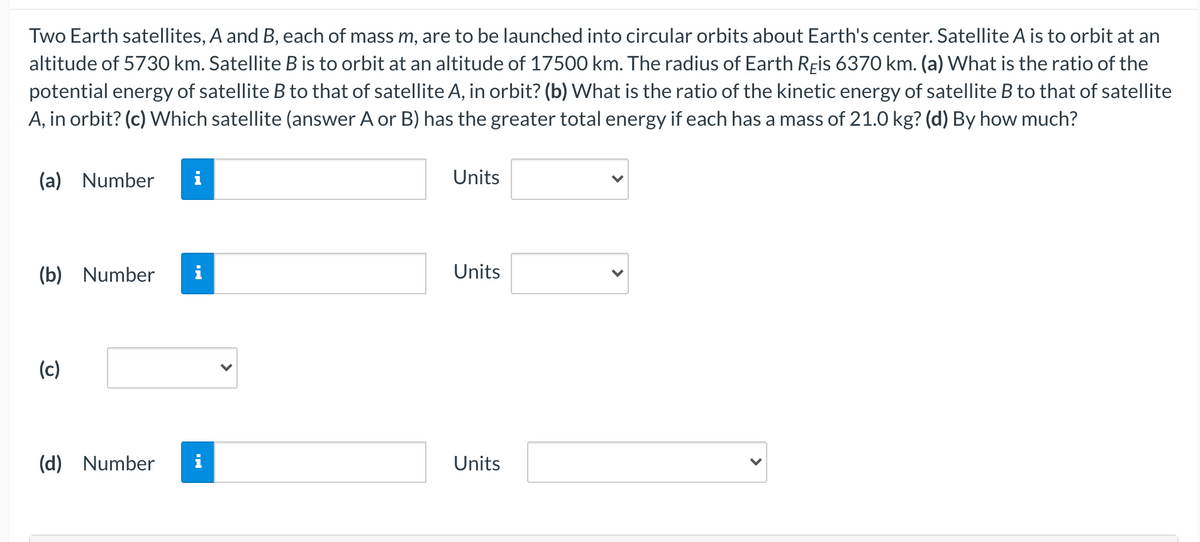Two Earth satellites, A and B, each of mass m, are to be launched into circular orbits about Earth's center. Satellite A is t OI altitude of 5730 km. Satellite B is to orbit at an altitude of 17500 km. The radius of Earth Reis 6370 km. (a) What is the rati potential energy of satellite B to that of satellite A, in orbit? (b) What is the ratio of the kinetic energy of satellite B to that A, in orbit? (c) Which satellite (answer A or B) has the greater total energy if each has a mass of 21.0 kg? (d) By how much?
Two Earth satellites, A and B, each of mass m, are to be launched into circular orbits about Earth's center. Satellite A is t OI altitude of 5730 km. Satellite B is to orbit at an altitude of 17500 km. The radius of Earth Reis 6370 km. (a) What is the rati potential energy of satellite B to that of satellite A, in orbit? (b) What is the ratio of the kinetic energy of satellite B to that A, in orbit? (c) Which satellite (answer A or B) has the greater total energy if each has a mass of 21.0 kg? (d) By how much?
University Physics Volume 1
18th Edition
ISBN:9781938168277
Author:William Moebs, Samuel J. Ling, Jeff Sanny
Publisher:William Moebs, Samuel J. Ling, Jeff Sanny
Chapter11: Angular Momentum
Section: Chapter Questions
Problem 57P: A Molniya orbit is a highly eccentric orbit of a communication satellite so as to provide continuous...
Related questions
Question
100%
Please help me

Transcribed Image Text:Two Earth satellites, A and B, each of mass m, are to be launched into circular orbits about Earth's center. Satellite A is to orbit at an
altitude of 5730 km. Satellite B is to orbit at an altitude of 17500 km. The radius of Earth Reis 6370 km. (a) What is the ratio of the
potential energy of satellite B to that of satellite A, in orbit? (b) What is the ratio of the kinetic energy of satellite B to that of satellite
A, in orbit? (c) Which satellite (answer A or B) has the greater total energy if each has a mass of 21.0 kg? (d) By how much?
(a) Number
Units
(b) Number
Units
(c)
(d) Number
Units
Expert Solution
This question has been solved!
Explore an expertly crafted, step-by-step solution for a thorough understanding of key concepts.
This is a popular solution!
Trending now
This is a popular solution!
Step by step
Solved in 3 steps

Knowledge Booster
Learn more about
Need a deep-dive on the concept behind this application? Look no further. Learn more about this topic, physics and related others by exploring similar questions and additional content below.Recommended textbooks for you

University Physics Volume 1
Physics
ISBN:
9781938168277
Author:
William Moebs, Samuel J. Ling, Jeff Sanny
Publisher:
OpenStax - Rice University

Classical Dynamics of Particles and Systems
Physics
ISBN:
9780534408961
Author:
Stephen T. Thornton, Jerry B. Marion
Publisher:
Cengage Learning

University Physics Volume 1
Physics
ISBN:
9781938168277
Author:
William Moebs, Samuel J. Ling, Jeff Sanny
Publisher:
OpenStax - Rice University

Classical Dynamics of Particles and Systems
Physics
ISBN:
9780534408961
Author:
Stephen T. Thornton, Jerry B. Marion
Publisher:
Cengage Learning